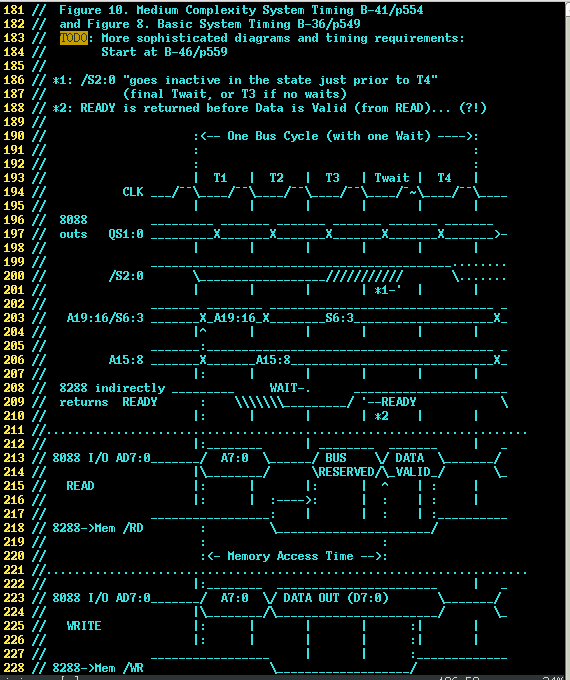Guess my brain wasn't in it, when I drew up the timing-diagrams shown in the last log.

OF COURSE the timing-specifications from the 8088 manual are for the 8088's *outputs*... They're guarantees of what the 8088 chip, itself, will do... so that, when interfacing with other chips you can make sure those other chips' input-timing requirements are met.
---------------
There's a *huge* difference between what's required to be within-specs, and what's guaranteed by the 8088.
---------------
SO... Again, there's basically no way my 8-bit AVR can possibly change 20 address-bits (three ports) in less than the 110ns guaranteed by the 8088, when a single AVR instruction (at 20MHz) is already 50ns, and that'd only handle *one* byte, of the three.
So far I've only dug up specs for the 8288 (which converts /S2:0 into /RD, /WR, etc.) and the 8087 FPU (which I don't intend on using in this early stage, BUT, should probably be a decent resource for expectations of the other 8088 outputs, like A19:0).
And...
Yep, those specs are *way* more lenient.
FURTHER, they're *MUCH* more indicative of what's going on...
I couldn't figure out from the 8088's timing-diagrams *when* these signals were supposed to be *sampled*... Falling-edge? Rising-edge? (are they level-sensitive? E.G. A15:8 being fed directly to a memory-device?)
But e.g. the 8288 datasheet shows, for the /S2:0 signals, very clear "setup" and "hold" times, very clearly surrounding a specific clock-edge. Similarly of the 8087's datasheet showing which *edge* the Address-bits need to be setup for (and held after).
Those setup/hold times are shown as minimums, with no maximums... and worst-case we have a minimum setup-time of 35ns.
One 8088 bus clock-cycle is 1/4.77MHz=210ns, leaving a whopping 185ns of extra potential setup-time in many cases!
So, then, rather than having to switch all the Address inputs (three bytes) within the 8088's spec'd 110ns, we actually have 185ns to work with. That's doable.
And, further, some of those signals may not even be sampled at every clock, so might be changed in a prior clock-cycle than the one where it's needed.
E.G. If it can be determined that A15:8 are only paid-attention-to after
the latching of A19:16 and A7:0, and only until, e.g., the end of
Data-Out, then it might be possible to change the address-bits *before*
the next cycle, e.g. in T4 alongside the change of /S2:0...
Similarly, it might be possible to stretch those timings a bit:
A prime example might be, again, A15:8. The higher and lower address-bits are time-multiplexed with status-signals and data, but A15:8 aren't multiplexed at all. Since the others are Muxed, and must therefore be *latched* through a separate latch-chip, that means the entirety of A19:0 won't be available to devices until those latches are latched *and* their propagation-delays... So, then, realistically... it's probably reasonable to assume that no devices attached to the address-bits actually look at the address until *after* that time... so then A15:8 could plausibly be changed even slightly after the other bits' latch-clock-edge. (Or, at the very least, should probably be the *last* bits written, when writing the address-bits).
Anyways, it's starting to seem less implausible. And maybe even possible without synchronizing the AVR clock to the 8088 clock too accurately.
 Eric Hertz
Eric Hertz
Discussions
Become a Hackaday.io Member
Create an account to leave a comment. Already have an account? Log In.